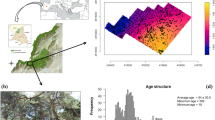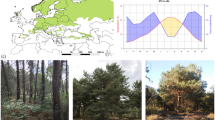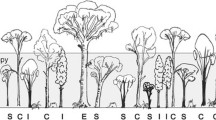Abstract
Studying species interactions in mixed forests allows us to assess their potential benefits and adapt current silvicultural tools developed in monospecific stands to multi-specific stands. We analyzed tree interactions in a Pinus halepensis Mill. and Pinus pinea L. mixed plantation using individual tree neighborhood models and competition indices that accounted for symmetric and asymmetric competition, to analyze whether the growth of each species was better explained by symmetric or asymmetric competition. We also split the competition indices into their intra- and interspecific forms, to test for competition effects on growth change based on competitor identity. Finally, we analyzed whether P. halepensis and P. pinea trees had different growth responses to competition. When calculating competition indices, we explored how spatial information and size of competitor trees contributed to the quantification of the process. Competition measurements were optimized to more precisely describe interactions. Results showed that the inclusion of competition indices generated important improvements in growth models. The main mode of competition was symmetric, which could be related to water restrictions typical of the Mediterranean climate. Considering competitor identity did not improve the growth models, while measurement without discriminating competitors by species generated more parsimonious models. P. halepensis and P. pinea trees had similar growth responses to competition, indicating that the two species cope with competition in similar ways. However, P. pinea showed lower average growth than P. halepensis in the period analyzed. Results suggest that preventing the onset of intense interspecific competition processes could help slow down the long-term replacement of P. pinea by P. halepensis and could have benefits for silvicultural management in systems with two species that share ecological niches but are capable of generating different goods and services.

Similar content being viewed by others
References
Aakala T, Fraver S, D’Amato AW, Palik BJ (2013) Influence of competition and age on tree growth in structurally complex old-growth forests in northern Minnesota, USA. For Ecol Manage 308:128–135
Anderson DR (2007) Model based inference in the life sciences: a primer on evidence. Springer, New York
Bartoń K (2016) MuMIn: multi-model inference. R package version 1.40.0. https://CRAN.Rproject.org/package=MuMIn
Bates D, Mächler M, Bolker B, Walker S (2015) Fitting linear mixed-effects models using {lme4}. J Stat Softw 67:1–48. https://doi.org/10.18637/jss.v067.i01
Biondi F (1999) Comparing tree-ring chronologies and repeated timber inventories as forest monitoring tools. Ecol Appl 9:216–227
Bravo F, Hann DW, Maguire DA (2001) Impact of competitor species composition on predicting diameter growth and survival rates of Douglas-fir trees in southwestern Oregon. Can J For Res 31:2237–2247. https://doi.org/10.1139/x01-164
Bravo-Oviedo A, del Río M, Calama R, Valentine HT (2014) New approaches to modelling cross-sectional area to height allometry in four Mediterranean pine species. Forestry 87:399–406. https://doi.org/10.1093/forestry/cpt058
Bunn AG (2008) A dendrochronology program library in R (dplR). Dendrochronologia 26:115–124
Burkhart HE, Tomé M (2012) Modeling forest trees and stands. Springer, Berlin
Burton PJ (1993) Some limitations inherent to static indices of plant competition. Can J For Res 23:2141–2152
Calama R, Montero G (2005) Multilevel linear mixed model for tree diameter increment in stone pine (Pinus pinea): a calibrating approach. Silva Fenn 39:37–54
Cañadas MN, Güemes CG, Garriga E, Montero G (2001) Estimación de la dimensión de copa de los árboles de Pinus pinea L. en las masas del sistema central. In: III Congreso Forestal Español
Canham CD, LePage PT, Coates KD (2004) A neighborhood analysis of canopy tree competition: effects of shading versus crowding. Can J For Res 34:778–787
Castro EB (1997) Los bosques ibéricos: una interpretación geobotánica. GeoPlaneta, Editorial, SA
Cavard X, Bergeron Y, Chen HYH, Pare D (2010) Mixed-species effect on tree aboveground carbon pools in the east-central boreal forests. Can J For Res 40:37–47
Chen HY, Klinka K, Mathey A-H et al (2003) Are mixed-species stands more productive than single-species stands: an empirical test of three forest types in British Columbia and Alberta. Can J For Res 33:1227–1237
Collet C, Ningre F, Barbeito I et al (2014) Response of tree growth and species coexistence to density and species evenness in a young forest plantation with two competing species. Ann Bot 113:711–719
Collet C, Manso R, Barbeito I (2017) Coexistence, association and competitive ability of Quercus petraea and Quercus robur seedlings in naturally regenerated mixed stands. For Ecol Manage 390:36–46. https://doi.org/10.1016/j.foreco.2017.01.021
Condés S, Sterba H (2005) Derivation of compatible crown width equations for some important tree species of Spain. For Ecol Manage 217:203–218
Coomes DA, Allen RB (2007) Effects of size, competition and altitude on tree growth. J Ecol 95:1084–1097
Cubbage F, Harou P, Sills E (2007) Policy instruments to enhance multi-functional forest management. For Policy Econ 9:833–851
del Río M, Calama R, Cañellas I et al (2008) Thinning intensity and growth response in SW-European Scots pine stands. Ann For Sci 65:308
del Río M, Condés S, Pretzsch H (2014) Analyzing size-symmetric vs. size-asymmetric and intra- vs. inter-specific competition in beech (Fagus sylvatica L.) mixed stands. For Ecol Manage 325:90–98
Draper NR, Smith H, Pownell E (1998) Applied regression analysis. Wiley, Hoboken
Felton A, Nilsson U, Sonesson J et al (2016) Replacing monocultures with mixed-species stands: ecosystem service implications of two production forest alternatives in Sweden. Ambio 45:124–139. https://doi.org/10.1007/s13280-015-0749-2
Forrester DI (2014) The spatial and temporal dynamics of species interactions in mixed-species forests: from pattern to process. For Ecol Manage 312:282–292
Forrester DI, Kohnle U, Albrecht AT, Bauhus J (2013) Complementarity in mixed-species stands of Abies alba and Picea abies varies with climate, site quality and stand density. For Ecol Manage 304:233–242
Freckleton RP, Watkinson AR (1999) The mis-measurement of plant competition. Funct Ecol 13:285–287
Ganatsas P, Thanasis G (2010) Pinus halepensis invasion in Pinus pinea habitat in Strofylia forest (site of NATURA 2000 network), southern Greece. J Nat Conserv 18:106–117
García O (2014) Siplab, a spatial individual-based plant modelling system. Comput Ecol Softw 4:215–222
Goldberg DE (1996) Simplifying the study of competition at the individual plant level: consequences of distinguishing between competitive effect and response for forest vegetation management. NZJ For Sci 26:19–38
Goldberg DE, Werner PA (1983) Equivalence of competitors in plant communities: a null hypothesis and a field experimental approach. Am J Bot 70(7):1098–1104
Grams TEE, Andersen CP (2007) Competition for resources in trees: physiological versus morphological plasticity. In: Esser K, Löttge U, Beyschlag W, Murata J (eds) Progress in botany. Springer, Berlin, pp 356–381
Grivet D, Climent J, Zabal-Aguirre M et al (2013) Adaptive evolution of Mediterranean pines. Mol Phylogenet Evol 68:555–566
Jose S, Williams R, Zamora D (2006) Belowground ecological interactions in mixed-species forest plantations. For Ecol Manage 233:231–239
Kunstler G, Falster D, Coomes DA et al (2016) Plant functional traits have globally consistent effects on competition. Nature 529:204–207
Lara W, Bravo F, Sierra CA (2015) measuRing: an R package to measure tree-ring widths from scanned images. Dendrochronologia 34:43–50
Larocque GR, Luckai N, Adhikary SN et al (2012) Competition theory—science and application in mixed forest stands: review of experimental and modelling methods and suggestions for future research. Environ Rev 21:71–84
Liphschitz N, Lev-Yadun S, Rosen E, Waisel Y (1984) The annual rhythm of activity of the lateral meristems (cambium and phellogen) in Pinus halepensis Mill. and Pinus pinea L. IAWA J 5:263–274
Lorimer CG (1983) Tests of age-independent competition indices for individual trees in natural hardwood stands. For Ecol Manage 6:343–360
Lüdecke D (2017) sjPlot: data visualization for statistics in social science. R package version 2.4.0. https://CRAN.R-project.org/package=sjPlot
Mayfield MM, Levine JM (2010) Opposing effects of competitive exclusion on the phylogenetic structure of communities. Ecol Lett 13:1085–1093
Niinemets Ü, Valladares F (2006) Tolerance to shade, drought, and waterlogging of temperate Northern Hemisphere trees and shrubs. Ecol Monogr 76:521–547
Olivar J, Bogino S, Rathgeber C et al (2014) Thinning has a positive effect on growth dynamics and growth—climate relationships in Aleppo pine (Pinus halepensis) trees of different crown classes. Ann For Sci 71:395–404
Papaik MJ, Canham CD (2006) Multi-model analysis of tree competition along environmental gradients in southern new England forests. Ecol Appl 16:1880–1892
Pasho E, Alla AQ (2015) Climate impacts on radial growth and vegetation activity of two co-existing Mediterranean pine species. Can J For Res 45:1748–1756
Pommerening A, Maleki K (2014) Differences between competition kernels and traditional size-ratio based competition indices used in forest ecology. For Ecol Manage 331:135–143
Poorter L, Lianes E, Moreno-de Las Heras M, Zavala MA (2012) Architecture of Iberian canopy tree species in relation to wood density, shade tolerance and climate. Plant Ecol 213:707–722
Pretzsch H (1995) On the effect of the spatial distribution of trees on the stand growth. In: Conference paper, short version
Pretzsch H (2009) Forest dynamics growth and yield: from measurement to model. Springer, Berlin
Pretzsch H, Biber P (2010) Size-symmetric versus size-asymmetric competition and growth partitioning among trees in forest stands along an ecological gradient in central Europe. Can J For Res 40:370–384. https://doi.org/10.1139/X09-195
Pretzsch H, Schütze G (2016) Effect of tree species mixing on the size structure, density, and yield of forest stands. Eur J For Res 135:1–22
Pretzsch H, Forrester DI, Bauhus J (2017) Mixed-species forests: ecology and management. Springer, Berlin
Puértolas J, Sierra R, Pardos JA (2005) Comportamiento fisiológico de una plantación de Pinus halepensis y Pinus pinea en un antiguo terreno agrícola. In: IV Congreso Forestal Español
Puettmann KJ, Coates KD, Messier CC (2012) A critique of silviculture: managing for complexity. Island Press, Washington
Pukkala T, Miina J, Palahí M (2002) Thinning response and thinning bias in a young Scots pine stand. Silva Fenn 36:827–840
R Core Team (2016) R: a language and environment for statistical computing
San-Miguel-Ayanz J, de Rigo D, Caudullo G et al (2016) European atlas of forest tree species. Publication Office of the European Union, Luxembourg
Schwinning S, Weiner J (1998) Mechanisms determining the degree of size asymmetry in competition among plants. Oecologia 113:447–455
Serrada R (2008) Apuntes de selvicultura. Servicio de Publicaciones, EUIT Forestal, Madrid
Tilman D (1988) Plant strategies and the dynamics and structure of plant communities. Princeton, Princeton University Press
Tomé M, Burkhart HE (1989) Distance-dependent competition measures for predicting growth of individual trees. For Sci 35:816–831
Weston S, Calaway R (2015) Getting started with doparallel and foreach. Available https://cran.r-project.org/web/packages/doparallel/vignettes/gettingstartedparallel.pdf
Zuur AF, Ieno EN, Walker NJ, Savaliev AA, Smith GM (2009) Mixed effects models and extensions in R. In Gail M, Krickeberg K, Samet JM, Tsiatis A, Wong W (eds). Springer, New York
Acknowledgements
This study was funded by the Spanish National Project (AGL2014-51964-C2-1-R).
Author information
Authors and Affiliations
Corresponding author
Additional information
Communicated by Miren del Rio.
Electronic supplementary material
Below is the link to the electronic supplementary material.
Rights and permissions
About this article
Cite this article
Cattaneo, N., Bravo-Oviedo, A. & Bravo, F. Analysis of tree interactions in a mixed Mediterranean pine stand using competition indices. Eur J Forest Res 137, 109–120 (2018). https://doi.org/10.1007/s10342-017-1094-8
Received:
Revised:
Accepted:
Published:
Issue Date:
DOI: https://doi.org/10.1007/s10342-017-1094-8




